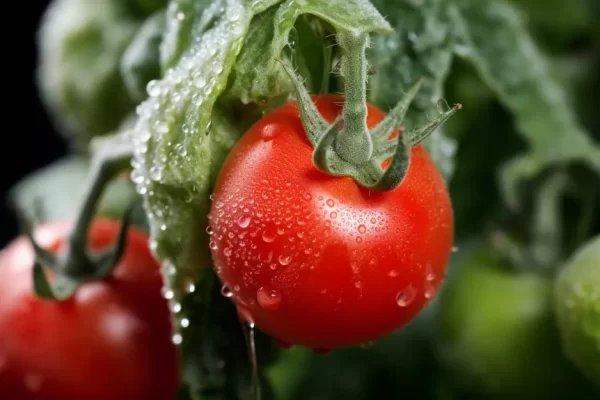Powdery mildew is one of the most common fungal diseases affecting tomato crops worldwide, posing a serious threat to yields and plant health. This disease is marked by a white or gray powdery layer on the leaves, stems, and fruits of tomato plants, which can lead to reduced photosynthesis, weakened plants, and even total crop failure if left untreated. Fortunately, organic control methods provide effective ways to manage powdery mildew, reducing the dependency on chemical pesticides and promoting sustainable farming.
In this post, we’ll explore the causes and symptoms of powdery mildew in tomato crops, along with effective organic solutions to prevent and control its spread.
Understanding Powdery Mildew in Tomato Crops
Causes: Powdery mildew is caused by several fungal pathogens, most commonly Leveillula taurica and Oidium lycopersicum, which thrive in warm, dry conditions with high humidity. This disease often appears in greenhouses or other environments with limited airflow, as well as during periods when daytime temperatures are warm, and nights are cool.
Symptoms: The initial symptoms of powdery mildew on tomato plants include small, white, powdery spots that typically appear on the upper side of the leaves. As the infection spreads, these spots can merge and cover large leaf areas, leading to leaf curling, yellowing, and eventually premature leaf drop. This disease also affects the stems and fruits, weakening the plant and making it susceptible to other diseases.
Organic Control Measures to Combat Powdery Mildew
Controlling powdery mildew organically involves a combination of preventive measures and direct treatments. Let’s dive into the most effective methods:
1. Improving Air Circulation
Tomato plants need good air circulation to reduce humidity and inhibit fungal growth. Space plants adequately when planting, allowing ample room for air to move freely around each plant. Pruning the lower leaves and any crowded areas can also improve air circulation, reducing the risk of powdery mildew.
2. Watering Techniques
Powdery mildew thrives in conditions where the plant’s foliage remains moist for long periods. To minimize this, use drip irrigation instead of overhead watering to keep water off the leaves. Also, water early in the morning so that any moisture on the foliage can evaporate quickly.
3. Applying Neem Oil
Neem oil is a well-known organic remedy for powdery mildew and other fungal diseases. It acts as both a preventive and treatment measure, inhibiting fungal spore growth while providing a protective coating on leaves. To make a neem oil spray, mix 2-3 tablespoons of neem oil with a gallon of water and a few drops of mild liquid soap. Spray the solution on affected and surrounding plants every 7-10 days.
4. Using Baking Soda Solution
Baking soda (sodium bicarbonate) is a natural antifungal agent that alters the pH level on leaf surfaces, making it difficult for powdery mildew to thrive. To make a baking soda solution, mix 1 tablespoon of baking soda with 1 tablespoon of liquid soap and a gallon of water. Spray this mixture on the affected plants weekly, especially on the top and bottom of leaves, until the mildew subsides.
5. Applying Milk Spray
Milk has shown promising results as an organic fungicide for powdery mildew. Research suggests that milk proteins can stimulate the plant’s immune system and reduce fungal growth. Mix milk with water in a 1:10 ratio and spray this mixture on the leaves every 7-10 days. Make sure to use fresh milk, as spoiled milk can attract pests.
6. Sulfur Dusting
Sulfur is an age-old natural fungicide that can be very effective against powdery mildew. Dusting plants with sulfur disrupts the fungal spores’ development, stopping the spread of mildew. However, sulfur should be used sparingly, as overuse can damage plant tissues, especially in hot weather. Follow the label instructions carefully when applying sulfur.
7. Introducing Beneficial Microorganisms
Beneficial fungi and bacteria, such as Bacillus subtilis, can be applied as a foliar spray to combat powdery mildew. These microorganisms compete with powdery mildew spores, preventing them from colonizing plant surfaces. Many commercial organic products contain beneficial microorganisms specifically formulated for powdery mildew control.
Preventive Practices to Keep Powdery Mildew at Bay
While the above treatments are effective, the best way to manage powdery mildew is by preventing it from infecting your tomato plants in the first place. Here are a few preventive measures:
- Choose Resistant Varieties: Some tomato varieties are naturally resistant to powdery mildew. When planning your crop, consider using resistant cultivars to reduce the likelihood of infection.
- Rotate Crops: Fungal pathogens often persist in soil. By rotating tomato crops with non-susceptible crops, you can break the disease cycle and reduce future outbreaks.
- Remove Infected Plant Material: If you notice signs of powdery mildew, promptly remove the infected leaves or plants to prevent the spread. Dispose of these parts carefully, and do not compost them, as the fungus can survive and spread through compost.
- Use Organic Mulch: Mulching with organic materials like straw or compost can help regulate soil moisture levels and prevent water from splashing onto the leaves, which could carry fungal spores.
When to Seek Additional Help
In cases of severe powdery mildew infestation, organic methods may not fully eradicate the disease, especially if it has already spread significantly across the crop. If symptoms persist or worsen, it may be necessary to consult with an agricultural extension officer or local expert. They can help determine if a different approach is needed or if it’s time to use more intensive treatments.
Conclusion: Embracing Organic Solutions for Healthier Tomato Crops
Powdery mildew poses a significant threat to tomato crops, but with careful planning and the right organic control measures, it can be effectively managed. Organic practices like using neem oil, baking soda, milk sprays, and beneficial microorganisms offer safe, sustainable alternatives to chemical fungicides. By focusing on prevention and early intervention, farmers can protect their crops and contribute to a healthier, more sustainable agricultural environment.

